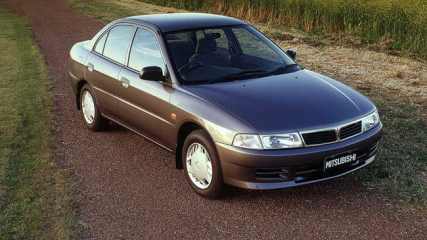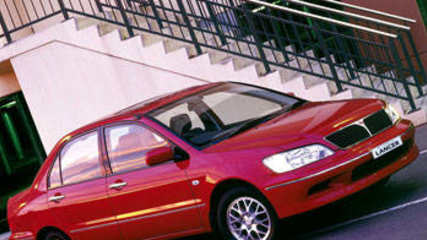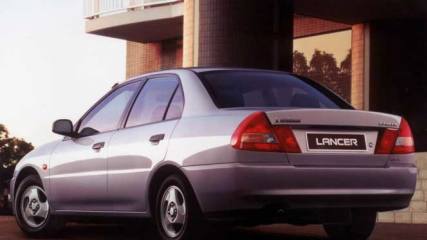Used Mitsubishi Lancer review: 1996-2002
By Graham Smith · 23 Nov 2017
The Mitsubishi Lancer is a Japanese car designed and made to a high quality, making it one of the leaders in the small car class.Aimed at the conservative buyer rather than the one looking for excitement, the CE Lancer was often driven gently and well maintained by caring, sometimes, older drivers.The CE Lancer was introduced in 1996 and ran through until 2004.It was a small front-wheel drive car available in practical four-door sedan, wagon and sporty two-door coupe bodystyles with a range of models including the GLi , GLXi, VR-X, LRXi, MR, and rally-bred Evolution.The GLi was the entry point and it was available as a two-door coupe and four-door sedan.A 1.5-litre four-cylinder petrol engine provided its power, and there was the choice of a four-speed automatic transmission and a five-speed manual gearbox.It was quite sparsely equipped; the standard features list consisted of cloth trim, power steering, remote releases for the boot and fuel filler, and a fairly basic radio cassette sound system with two speakers.The options list was also short, but included air conditioning and front airbags for the driver and front passenger.For more you had to step up to the GLXi, which was available as a coupe, sedan and wagon.It had a larger, 1.8-litre four-cylinder engine, and the choice of a four-speed automatic transmission or five-speed manual gearbox.Being more up-range than the GLi, the GLXi was better equipped and had four speakers, central locking, power mirrors, and a tachometer.Options included manual air conditioning, a single airbag for the driver, and dual airbags for the driver and front passenger.The sporty MR coupe had a 1.8-litre four-cylinder engine and the choice of four-speed automatic transmission and five-speed manual gearbox.It boasted four-speakers, alloy wheels, a sporty body kit, central locking, power mirrors, power windows, a tachometer, and fog lights.Options were air conditioning and front airbags for the driver and front passenger.An update in 2001 saw the 1.8-litre engine become available on the GLi coupe, and standard on the GLi sedan.Also standard was a driver’s airbag, power mirrors, and a CD player.In the same update the GLXi got power windows, central locking and a CD player.Limited Edition LRX-1 coupes and sedans were launched in 2001 with 14-inch alloy wheels, a CD stacker, and rear spoiler.Mitsubishi also added a hero model to the range in 2001 in the form of the rally-bred Evolution VI sedan.Aimed squarely at the enthusiast driver, the Evo VI had dual front airbags, ABS brakes, Emergency Brakeforce Distribution, traction control, electronic stability control, 17-inch alloy wheels, multi-function steering wheel, sports seats, power windows and mirrors, CD player, central locking, air conditioning, a sports body kit, and an alarm to deter thieves.Modern features like Bluetooth to connect an iPhone or Android device weren’t available.It didn’t have a touchscreen or sat nav either, and the air conditioning was manual, not automatic climate control.You won't find aids like a reversing camera or parking sensors either, or a park assist system.Also missing was the option of a sunroof.The spare tyre was full-sized.Despite its small stature the Lancer had seats for five and could cut it as a family car if the kids were young.Interior space in the front seats was good on all models. The rear could be tight in the coupe, but was generally fine in the sedans and wagons with their extended rooflines.In a rather bland interior awash with grey plastics, cupholders were provided in the front.Two single overhead camshaft four-cylinder engines were offered. They were fuel-injected and both ran on 91-octane regular unleaded petrol, and could be run on E10 ethanol blend fuel if so desired.One was a 1.5-litre, which powered the GLi, the other a larger 1.8-litre unit, which powered most models in the range. Both offered a combination of solid performance and good fuel economy.When working at its peaks the 1.5-litre engine was putting out peak power of 69kW (83 horsepower), and 126Nm of torque.The 1.8-litre engine put out maximum power of 86kW (115 horsepower), and 161Nm of torque.The Evo VI had a turbocharged 2.0-litre four-cylinder engine that thundered out a whopping 206 kW (276 horsepower), and 375 Nm of torque.It came with a five-speed manual gearbox and was all-wheel drive.For performance, it’s best to forget cars with the 1.5-litre engine, its zip is lacklustre at best.The 1.8-litre engine is the pick of the bunch; its performance in manual or automatic form is quite good.The Lancer’s combination of independent front suspension and multi-link independent rear suspension gives it a reassuring stability on the road, with a good level of grip and responsiveness.Being a small car the manoeuvrability is easy, with a tight turning circle to aid driving in town and parking in tight spaces.Road noise can be annoying, but most owners are prepared to dismiss it as being normal with such a low-priced car.Generally, the CE Lancer was a strong little car that stood up well in crash testing.When launched the safety features were limited to lap-sash seat belts, airbags for the driver and front passenger were available, but only as options.That changed in 2001 when a driver’s airbag became standard, which makes that a key consideration when shopping.ANCAP rated the dual airbag models at three stars.ISOFIX baby car seat mounting points weren’t fitted; it was too early for them.Quality, condition and service history are the most important things to consider when choosing a cheaper car.Buy the best car you can afford, in the best condition, with a solid service history and you shouldn’t go wrong.The CE Lancer had an enviable reputation for reliability, but it depends heavily on being well serviced.Mitsubishi recommended servicing the CE Lancer every 10,000km or 12 months, and it’s important to adhere to that if you value reliability.The oil to use is 15W-40.Capped price servicing didn’t apply to the CE Lancer, but service costs are not excessive, and any competent mechanic can do it.Mechanics who regularly work on them say the CE Lancer gives little trouble, although they stress that it’s important to change the cam timing belt as per Mitsubishi’s recommendation of 90,000 km.Walk away from any car that hasn’t been properly maintained, even if it appears a cheap buy.When new the CE Lancer was covered by a three-year/100,000km warranty.Older cars tend to get knocked about by owners who couldn’t care less, so look closely for panel damage that has been poorly repaired.When you lift the bonnet, look for oil leaks around the engine and gearbox.Peeling paint can be an issue. It’s not uncommon to find the clear coat peeling away. There’s nothing that can be done to fix it, short of repainting panels.MORE: If anything crops up, you’ll probably find it on our Mitsubishi Lancer problems page http://www.carsguide.com.au/mitsubishi/lancer/problems)Geoffrey Jarvis: I bought a used CE Lancer in 2004. It had done 55,000km at the time and I drove it until it had done 210,000km. I found it to be reliable, with good handling, performance and economy. I heartily recommend it.Raylene Meyer: I bought my GLi a year ago. It’s great to drive, is reliable and cheap to run. My only concern is that it’s difficult to install a baby car seat in the back seats.Sean Evans: I’ve owned two GL models and had a good run out of both. Both did more than 400,000 km, and were very reliable.Barry Thomas: It’s a great little car for driving around town, it will get you where you want to go with minimum fuss and little cost. The only complaint is that it’s a little cramped in the back.VW PoloGreat driver, but can be expensive as kays climb.3 stars.Toyota EchoCute, roomy, and Toyota quality, what more could you ask for in a cheapie.3.5 stars.Nissan PulsarWell-built, solid and reliable small car.3.5 stars.










